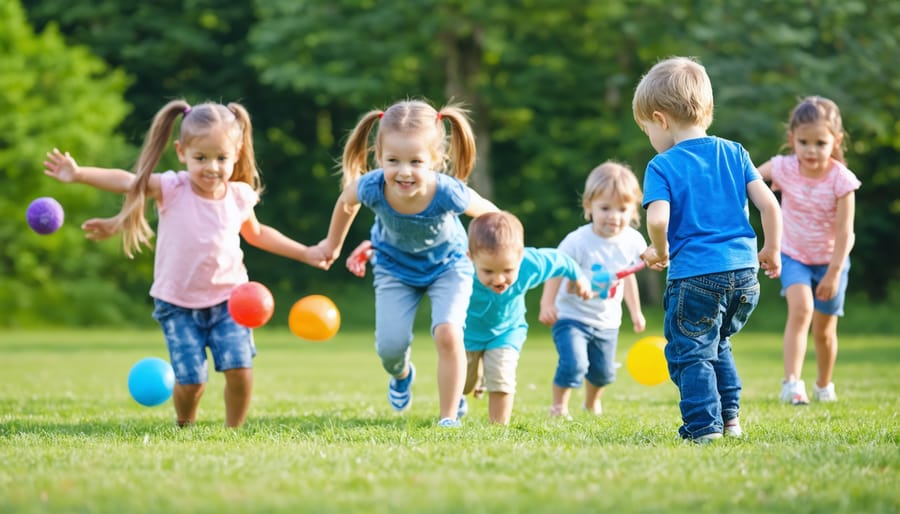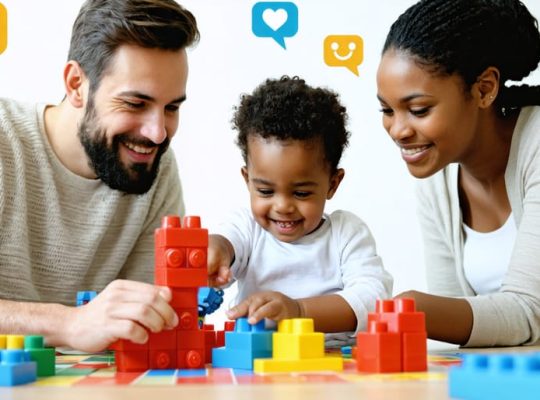In an era where screens dominate and processed foods tempt, our children’s health hangs delicately in the balance. Research shows that active kids perform better academically, develop stronger social skills, and maintain healthier weights throughout their lives. Yet today’s children spend an average of 7.5 hours daily on entertainment media, while only one in three achieves the recommended 60 minutes of daily physical activity.
But there’s hope. Simple, everyday choices can transform our children’s health trajectories. Whether it’s turning daily chores into dance parties, replacing video games with backyard adventures, or involving kids in meal planning and preparation, small changes create lasting impacts. The foundations we build today – through balanced nutrition and regular movement – shape not just our children’s physical health, but their mental well-being, self-confidence, and future success.
As parents and caregivers, we hold the power to inspire healthy habits that last a lifetime. This isn’t about strict regimens or unrealistic goals – it’s about making wellness fun, accessible, and natural for our children. Through understanding, encouragement, and consistent support, we can help our kids develop a positive relationship with exercise and healthy living that will serve them throughout their lives.
The Mind-Body Connection in Child Development
Exercise and Brain Development
Physical activity does more than just strengthen your child’s body – it’s a powerful catalyst for brain development and emotional regulation. When children engage in regular exercise, their brains release chemicals that enhance memory, improve focus, and boost learning capabilities.
Dr. Sarah Chen, a pediatric neurologist, explains: “Movement literally helps build better brains. When children run, jump, or dance, they’re creating new neural connections that support both cognitive and emotional development.”
Exercise increases blood flow to the brain, delivering oxygen and nutrients that help children stay alert and process information more effectively. Studies show that active children typically perform better academically and demonstrate stronger problem-solving skills.
Regular physical activity also helps children manage stress and anxiety naturally. During exercise, the brain releases endorphins – often called “feel-good hormones” – which help improve mood and reduce negative emotions. This natural mood boost can be especially beneficial during challenging school days or social situations.
Parents often notice that after physical activity, their children are more focused, calmer, and better able to handle daily challenges.
Nutrition’s Role in Mental Health
A well-balanced diet plays a crucial role in your child’s mental well-being, directly impacting their mood, behavior, and cognitive development. Research shows that children who eat nutritious meals throughout the day are better equipped to handle emotional challenges and maintain stable energy levels.
Key nutrients like omega-3 fatty acids, found in fish and nuts, support brain development and may help reduce symptoms of anxiety and depression in children. B-vitamins, abundant in whole grains and leafy greens, contribute to proper nervous system function and mood regulation.
Dr. Sarah Chen, a pediatric nutritionist, explains, “When children consume too many processed foods and sugary snacks, they often experience mood swings and difficulty concentrating. Instead, focusing on whole foods can help stabilize their blood sugar and improve their emotional resilience.”
Consider starting with small changes, like incorporating more colorful fruits and vegetables into meals, reducing processed snacks, and ensuring regular meal times. Remember that children learn eating habits by example, so modeling healthy food choices can positively influence their relationship with nutrition and mental health.
Creating Healthy Exercise Habits
Age-Appropriate Activities
Physical activity needs vary significantly as children grow. For toddlers (ages 1-3), focus on fundamental movements like running, jumping, and climbing. Structured activities should be simple and fun, such as dance parties, follow-the-leader, or obstacle courses designed with safety in mind.
Preschoolers (ages 3-5) benefit from activities that develop coordination and balance. Swimming lessons, tricycle riding, and playground games are excellent choices. These activities also support building social skills through group activities while keeping children active.
School-age children (6-12) are ready for more complex activities. Team sports like soccer or basketball help develop coordination and teamwork. Individual activities such as gymnastics, martial arts, or cycling can build confidence and physical literacy. Aim for a mix of structured sports and free play.
Teenagers (13-18) should engage in both cardio and strength-training activities. Sports teams, running clubs, or dance classes provide excellent workout opportunities. Weight training can begin with proper supervision and technique instruction. The key is finding activities they enjoy and will stick with long-term.
Remember to always consider your child’s individual interests and abilities when choosing activities. Start gradually and make adjustments based on their comfort level and enthusiasm. The goal is to make physical activity an enjoyable, lifelong habit.

Making Exercise Fun
Exercise doesn’t have to feel like a chore for children. The key is to transform physical activity into exciting fun wellness activities that naturally appeal to their sense of play and imagination. Try turning everyday movements into games – like “the floor is lava” to encourage jumping and climbing, or “animal walks” where children move like different creatures.
Dancing parties are another excellent way to get kids moving. Put on their favorite music and let them express themselves freely through movement. For younger children, songs with actions like “Head, Shoulders, Knees, and Toes” combine learning with physical activity.
Create obstacle courses using household items like pillows, boxes, and chairs. This not only provides exercise but also develops problem-solving skills and coordination. Outdoor scavenger hunts combine walking or running with exploration and discovery, making exercise feel like an adventure.
Team activities can make movement more engaging – simple games like tag, soccer, or follow-the-leader encourage both physical activity and social interaction. Even daily tasks can become fun challenges: racing to clean up toys, having jumping competitions while waiting in line, or playing “exercise Simon Says.”
Remember to join in the activities yourself – children are more likely to engage when they see adults participating enthusiastically. The goal is to make movement feel natural and enjoyable rather than forced or mandatory.
Building Better Nutrition Habits
Brain-Boosting Foods
A balanced diet rich in specific nutrients can significantly enhance your child’s cognitive development and mental performance. Studies show that omega-3 fatty acids, found in fatty fish like salmon and sardines, play a crucial role in brain development and memory function. These “brain-friendly” fats can be introduced through child-friendly meals like fish fingers or tuna sandwiches.
Blueberries, strawberries, and other colorful berries aren’t just delicious treats – they’re packed with antioxidants that support brain health and improve memory. Make these foods fun by creating rainbow fruit skewers or adding them to morning smoothies.
Eggs contain choline, a nutrient essential for brain development and memory function. Greek yogurt and lean meats provide protein and zinc, which help maintain focus and concentration throughout the day. For vegetarian options, legumes and nuts (if age-appropriate and allergy-safe) offer similar benefits.
Whole grains like quinoa and brown rice provide steady energy for the brain, helping children maintain concentration during school hours. Dark leafy greens, rich in folate and iron, support overall brain function – try incorporating them into smoothies or homemade pizza toppings.
As Dr. Sarah Chen, pediatric nutritionist, notes, “The key is making these brain-boosting foods part of regular meals in ways children will enjoy. Small, consistent changes in diet can make a big difference in cognitive development.”

Overcoming Picky Eating
Dealing with picky eating is a common challenge for many parents, but there are effective strategies for encouraging healthy eating habits in children. The key is to remain patient and consistent while making mealtimes positive experiences.
Start by introducing new foods alongside familiar favorites. Children often need to see a new food 10-15 times before accepting it. Try the “one-bite rule” where children take just one taste, without pressure to finish. Celebrate their willingness to try rather than focusing on whether they liked it.
Make food fun and engaging by involving kids in meal preparation. Let them help with safe kitchen tasks like washing vegetables or mixing ingredients. This ownership often increases their interest in trying new foods. Consider creative presentations, like arranging fruits and vegetables into funny faces or using colorful plates.
Maintain regular meal schedules and avoid using food as a reward or punishment. Offer healthy snacks between meals and remember that children naturally regulate their food intake. If they refuse a meal, stay calm and don’t prepare alternatives – they’ll likely be hungry enough to try something new at the next mealtime.
Model good eating habits yourself, as children often mimic adult behaviors. Eat together as a family when possible and keep the atmosphere light and conversational. Remember that picky eating is usually a phase that children outgrow with gentle guidance and consistent support.
Family-Based Approach to Health

Creating a Supportive Environment
Creating a supportive environment for your child’s health and exercise journey starts with leading by example. Children naturally look to their parents and caregivers as role models, so when they see you prioritizing physical activity and healthy choices, they’re more likely to follow suit.
Make exercise a family affair by planning active outings together, such as weekend bike rides, nature walks, or dance parties in the living room. Keep the focus on fun rather than performance, and celebrate everyone’s participation regardless of skill level. Remember, the goal is to create positive associations with physical activity that will last a lifetime.
Set up your home to encourage movement by keeping sports equipment easily accessible and creating safe spaces for active play. Consider designating an area where children can freely move, jump, and explore without worry. Remove barriers to physical activity by limiting screen time and establishing regular “active hours” in your daily routine.
Positive reinforcement plays a crucial role in supporting healthy behaviors. Instead of using exercise as punishment or reward, praise your child’s effort, improvement, and willingness to try new activities. Use encouraging language like “I love watching you play!” or “You’re getting stronger every day!”
Build a community of support by connecting with other families who share similar health goals. Organize group activities, join sports teams, or participate in community events that promote physical activity. This not only makes exercise more enjoyable but also helps children develop social skills while staying active.
Remember to be patient and flexible in your approach. Some days will be more active than others, and that’s perfectly okay. The key is to maintain a consistent, supportive atmosphere that makes healthy living feel natural and enjoyable for the whole family.
Addressing Common Challenges
Maintaining healthy exercise habits for children can be challenging, but there are practical solutions for the most common obstacles families face. Let’s address these challenges head-on with proven strategies that work in real-world situations.
Time constraints often top the list of barriers. Dr. Sarah Chen, a pediatric health specialist, suggests breaking physical activity into smaller chunks throughout the day. “Even 10-minute activity breaks can add up to make a significant difference,” she explains. Try incorporating movement into daily routines – walking to school, dancing while getting dressed, or doing jumping jacks during TV commercial breaks.
Screen time competition is another significant challenge. Instead of fighting technology, use it as a tool. Many families have found success with active video games or fitness apps designed for children. You can also establish a “move to earn” system where active play time earns screen time.
Weather restrictions can limit outdoor activities, but indoor alternatives are plentiful. Create an indoor obstacle course, play hide-and-seek, or have a dance party. Lisa Martinez, a mother of three, shares, “We transformed our basement into an active play zone with simple equipment like hula hoops and jump ropes.”
Lack of interest can be addressed by making exercise fun and social. Arrange active playdates, join family-friendly sports leagues, or create movement-based games. Remember that children are more likely to stay active when they enjoy what they’re doing and when they see their family members participating too.
For children who feel self-conscious about physical activity, focus on non-competitive activities and celebrate personal improvements rather than comparing performance with others.
As we’ve explored throughout this article, physical activity and exercise play a vital role in your child’s development, health, and happiness. Regular movement not only strengthens their bodies but also enhances their cognitive abilities, social skills, and emotional well-being. Remember that every child is unique, and finding activities that spark their interest is key to establishing lifelong healthy habits.
Start small and build gradually – even 15 minutes of active play can make a difference. Focus on making exercise fun and inclusive rather than competitive or demanding. Whether it’s dancing in the living room, playing tag in the backyard, or joining a local sports team, the most important thing is keeping your child moving and engaged.
Don’t forget that you’re their most influential role model. When children see their parents enjoying physical activity, they’re more likely to embrace it themselves. Make family exercise time a priority by scheduling regular active outings, trying new activities together, and celebrating everyone’s efforts and improvements.
Take action today by choosing one activity from this guide to try with your child. Pay attention to what they enjoy and build upon those preferences. Remember, supporting your child’s physical activity isn’t just about their health today – it’s an investment in their future well-being and success.
Together, we can help our children develop healthy, active lifestyles that will benefit them throughout their lives. The journey starts with a single step – yours.





